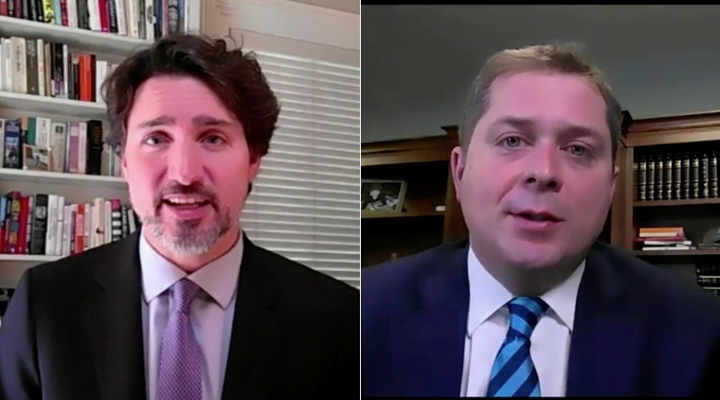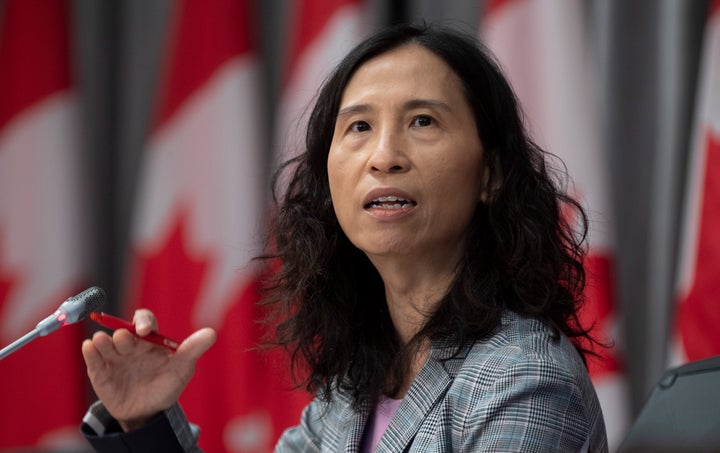
OTTAWA — The connectivity and audio issues the House of Commons speaker warned would happen in a new virtual sitting format happened Tuesday during the first meeting of a special committee on the COVID-19 pandemic.
Members of Parliament dialed in on Zoom, a video conferencing software, to pose questions to Prime Minister Justin Trudeau and members of his cabinet.
Despite Speaker Anthony Rota’s concerns raised last week in a procedural and House affairs committee meeting about a lax at-home dress code, MPs who appeared on camera all donned their business attire.
Connectivity issues, however, were evident with several MPs taking to Twitter to say they experienced trouble joining the virtual meeting.
Some MPs left their microphones on, which sometimes unexpectedly drew the camera away from the speaker. After a number of interruptions, Rota reminded noisy MPs that in this new format he has “the ability to mute them from here.”
Watch: Trudeau, Scheer discuss COVID-19 response during virtual session. Story continues below video.
With some provinces announcing plans to reopen sectors of the economy and certain public spaces, Conservative Leader Andrew Scheer said it will be necessary to ramp up the availability of test kits as officials mull easing health restrictions.
He pressed the government on the large number of companies awaiting Health Canada’s approval before they can distribute their test kits. “Once again, we see an example of government reacting very, very slowly and can’t keep up with entrepreneurs and with the private sector,” Scheer said.
Trudeau, dailing in from his Ottawa home, responded by referencing international concerns over faulty test kits. He defended the government’s approach, saying, “One of the huge challenges we might face, if tests are unreliable, is that we can have an undetected resurgence of COVID-19.”
The Opposition leader shifted his focus to Canadian start-up, BlueDot, an artificial intelligence platform used to track the spread of infectious diseases.
BlueDot was the first, according to the University of Toronto, to warn the world of the potential danger of a novel coronavirus, flagging the new illness nine days before the World Health Organization released a statement confirming the emergence of a “cluster of pneumonia cases” in Wuhan, China.
Did the government have access to BlueDot’s information in December, Scheer asked.
The prime minister didn’t give a direct answer. He said government officials were advised in early January about the emergence of a disease, which eventually became known as COVID-19. In reference to BlueDot, Trudeau said, “we are glad to have that company with us now.”
Trudeau said Canadian officials received intelligence about the emergence of the disease through “a range of intelligence services, public accounting and reporting, as well as our Five Eyes and other allies around the world.”
The quasi-question period in a video-conferencing format is a first for the House of Commons. The format is a question period and committee meeting fusion that came through an agreement to resume the House on a part-time basis.
Mute buttons and the virtual setting that favours one speaker at a time noticeably reduced the amount of heckling that goes on in comparison to the regular question period.
The Liberals, Bloc Québécois, and NDP passed a motion last week to hold one in-person sitting with a small group of MPs weekly, on Wednesdays, supplemented with two virtual sittings on Tuesdays and Thursdays.
Conservatives wanted two in-person meetings, arguing for more face-to-face opportunities to hold the government accountable, but their amendment was defeated.
While the Tuesday and Thursday virtual sessions are considered committee meetings, every Wednesday the House of Commons will formally sit and MPs may be asked to consider government business as well as participate in the question and answer period.
This week, the federal government is expected to table new legislation seeking Parliament’s approval to spend $9 billion to help students weather financial challenges amid the pandemic.
It will be the government’s third piece of COVID-19-related emergency legislation after bills proposing $82 billion for the taxable Canada Emergency Response Benefit, and $73 billion for the Canada Emergency Wage Subsidy received royal assent.

Earlier Tuesday, public health officials released updated modelling showing widespread physical-distancing measures are having an effect on the transmission of COVID-19, a contagious respiratory disease caused by the novel coronavirus.
More than 47,000 people have been diagnosed with COVID-19 in Canada as of Monday. At least 2,561 deaths — 79 per cent of them linked to long-term care homes and seniors’ residences — have been recorded as related to the disease.
In the early stages of the epidemic, the number of cases doubled every three days. Chief Public Health Officer Theresa Tam said Tuesday the rate of doubling is now every 16 days.

- What are the cases of the new coronavirus in Canada? Take a look at our map.
- Want to apply for the new CERB? Here’s what you need to know.
- What’s the difference between the coronavirus and the flu?
- You’ve probably been hearing a lot about PPE. What it is — and how to donate it.
- Things are changing quickly: a cross-Canada look at which services are open and closed.